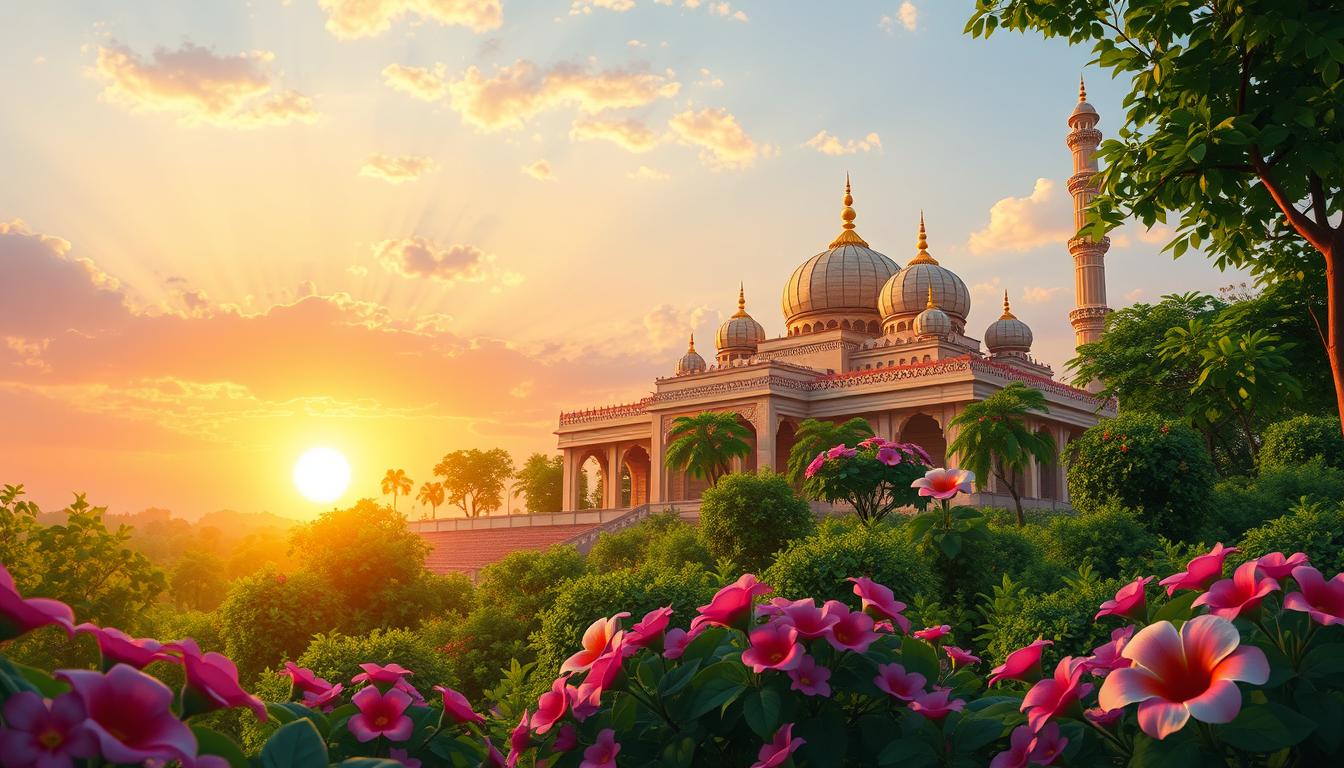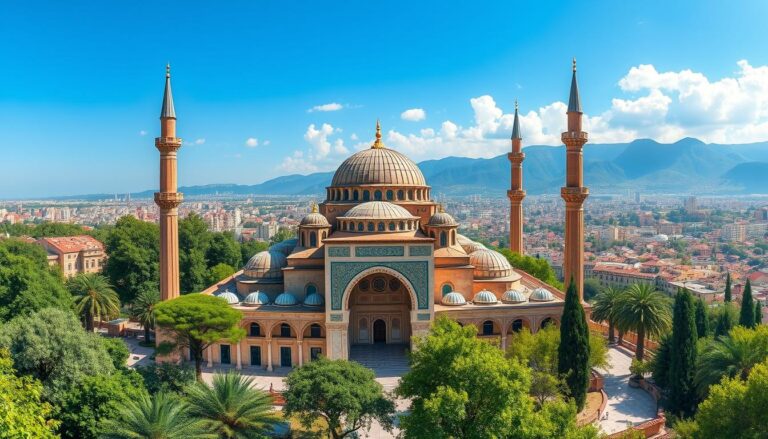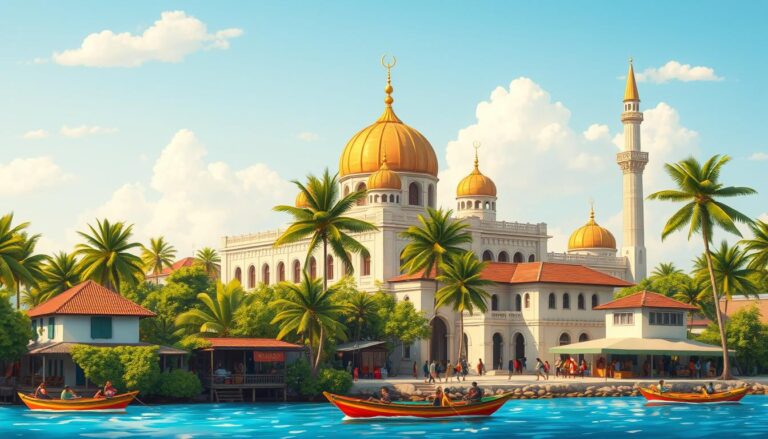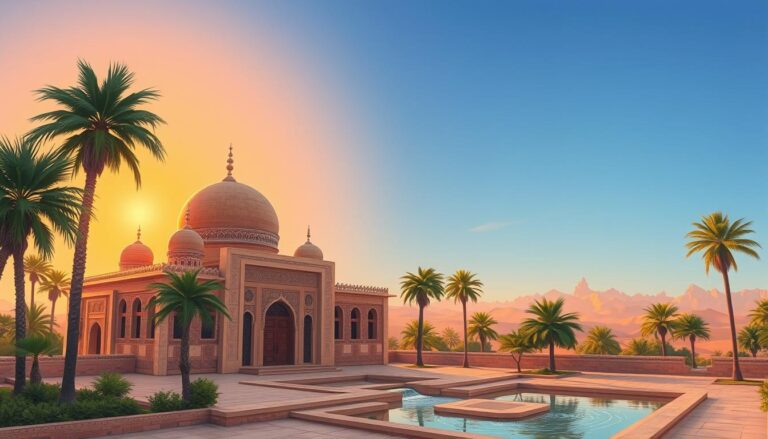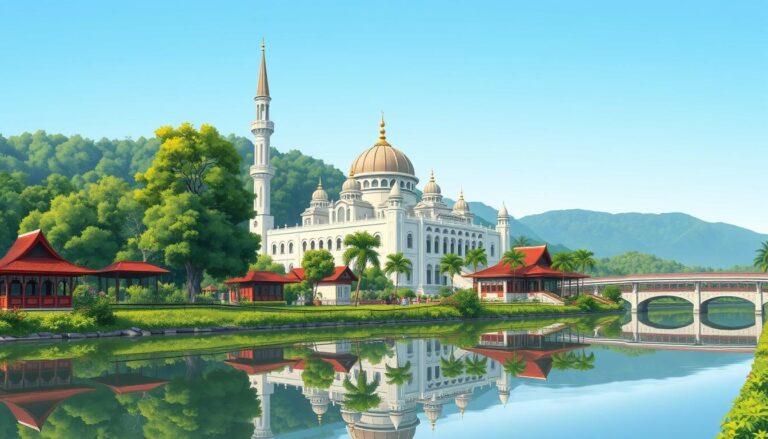Islam in Bangladesh
Islam is the main religion in Bangladesh, with about 90% of people following it. The first Arabs came to Chittagong in the 8th century, starting Islam’s spread. Sufi saints like Shah Jalal helped spread Islamic beliefs across the country.
In the Mughal era, Islam became the top religion, leading to many mosques and religious places. Even after Bangladesh became independent in 1971, Islam stayed a big part of the culture. The Constitution says Islam is the state religion.
The Islamic faith is a big part of Bangladeshi life. Events like Ramadhan celebrations and taraweeh prayers are important. Madrasas, or religious schools, also play a big role. Famous Bangladeshi Muslims, like Fazlur Rahman Khan and Muhammad Yunus, have made big contributions to the country.
The History of Islam in Bengal
The story of Islam in Bengal starts with early explorers and Arab traders. They came to the region many centuries ago. Today, archaeologists are digging up one of South Asia’s oldest mosques in northern Bangladesh. This shows Muslims were there around Prophet Muhammad’s time.
By the 9th century, Muslim merchants were boosting trade with Bengali ports. This helped bring Islam to the area. We see this in Abbasid era coins found in Bengal. Also, inscriptions near the Meghna River, close to Sandwip on the Bay of Bengal, tell us about this.
Early Explorers and Arab Traders
Arab writers like Al-Masudi talked about kingdoms like Samrup and Rumi. Rumi was linked to Dharmapal of the Pala Empire. In the 10th century, Samatata in southeastern Bengal was a place of diversity. It had a growing Muslim community, as Al-Masudi wrote in “The Meadows of Gold.”
“The Arab geographer Al-Masudi visited the region and documented a thriving Muslim community in his work The Meadows of Gold.”
The early days of Islam in Bengal highlight the impact of Arab traders and explorers. They introduced Islam, setting the stage for its growth. This led to the rise of the Bengal Sultanate in later centuries.
The Arrival of Islam through Conquest
The history of Islam in Bangladesh is closely tied to the Muslim conquest of Bengal in the 13th century. General Bakhtiyar Khilji’s forces led this conquest. It brought Islamic influence to the region for many years.
Many people in Bengal started to follow Islam. Muslim missionaries came after Khilji’s conquest.
The Rise of the Bengal Sultanate
In 1352, the unified Bengal Sultanate was formed by Shamsuddin Ilyas Shah. This was a big change for Islam in the area. The Sultanate supported Bengali language and culture.
The Ilyas Shahi dynasty valued Muslim learning. Sultan Jalaluddin Muhammad Shah funded Islamic schools in places like Mecca and Medina.
Traveler Ibn Battuta gave us important details about the Bengal Sultanate’s start. Over time, the Sultanate became a key place for Islamic learning and culture. It had a big impact on the Bengali people’s religion and language.
“The arrival of Islam into Bengal was accelerated by the conquest of Bengal by Muhammad ibn Bakhtiyar Khalji in the 13th century.”
Islam in Bangladesh
Cultural Influences and Practices
The Muslim community in Bengal, including Bangladesh and West Bengal, has unique cultural practices. These practices differ from the main Islamic traditions found elsewhere in India. The influence of Hinduism in Bangladesh has greatly shaped the Muslim community’s rituals and social structure.
Despite a strong personal commitment to Islam, Bangladeshi Muslims’ observance of Islamic rituals varies. This depends on their social status, where they live, and personal choices. In rural areas, beliefs and practices often mix with elements not found in orthodox Islam. Islamic scholar Aziz Ahmad notes that the Islam practiced in Bengal shows signs of Hindu syncretism.
Bangladesh is home to over 160 million people, making it the fourth-largest Muslim-majority nation. Most Bangladeshi Muslims are Sunnis, with a small Shia community mainly in cities. Islam is a big part of daily life, with almost every village having a mosque and an imam.
“The Islamic conquest of Bengal began in 1204 following the invasion by Muhammad bin Bakhtiyar Khalji, and Sufi sects established themselves in Bangladesh at an early stage. Wholesale conversion to Islam in what was to become Bangladesh began in the thirteenth century, and Sufism has traditionally been strong in the region.”
Bangladesh’s culture and religion are also shaped by Hindu, Buddhist, and Christian communities. These groups add to the country’s rich heritage. As Bangladesh faces modern challenges, keeping religious harmony and respecting diverse beliefs is key.
Other Religious Communities
Hinduism: The Second-Largest Faith
Hinduism is the second-largest religion in Bangladesh. About 13.1 million people call themselves Hindus. This makes up about 7.95 per cent of the population, according to the 2022 census.
Bangladesh’s Hindus are mostly Bengali Hindus. But, there are also Hindus among indigenous tribes like Garo and Khasi. Other tribes include Jaintia, Santhal, and Bishnupriya Manipuri.
Hindus live all over Bangladesh. They are most common in the north, southwest, and northeast. Hindu festivals like Durga Puja and Rath Yatra are celebrated everywhere. These festivals show the vibrant Hindu minority in the country.
“The Hindu population in Bangladesh has played a significant role in preserving the country’s rich cultural diversity and heritage.”
Buddhism and Christianity
Bangladesh is a country with many religions, including Buddhism and Christianity. About 0.63% of the people, or 1 million, follow Buddhism. Most of these Buddhists are in the Chittagong Hill Tracts region and follow Theravada Buddhism.
The Buddhist communities in Bangladesh have a long history. The Chakma, Marma, Mru, Khumi, Bawm, Chak, Kuki, Murang, Tanchangya, and Khiang tribes have practiced Theravada Buddhism for generations. This tradition is a big part of their cultural identity.
Christianity came to Bangladesh in the late 16th to early 17th centuries. It was brought by Portuguese traders and missionaries. Today, about 0.29% of the people, or half a million, are Christian. Most Christians live in big cities.
- Buddhism in Bangladesh accounts for around 0.63% of the total population.
- The majority of Bangladeshi Buddhists follow the Theravada school of Buddhism.
- Christianity arrived in Bangladesh in the late 16th to early 17th centuries through Portuguese influence.
- The Christian population in Bangladesh comprises approximately 0.29% of the total population.
“Buddhism and Christianity, though distinct in their origins and belief systems, have both found a place in the diverse religious landscape of Bangladesh, contributing to the country’s rich cultural tapestry.”
Islam in Bangladesh
Bangladesh is mostly Muslim, with over 90% of people following Islam. Islam became the state religion in 1988. Most Muslims in Bangladesh are Sunnis, making up about 88% of the population. A small number are Shias.
Islamic festivals and practices are big in Bangladesh. Events like Eid ul-Fitr and Eid ul-Adha are celebrated with joy. The Bishwa Ijtema, a huge Muslim gathering, happens here, attracting millions.
But, Bangladesh has faced problems with religious harmony. Attacks on minorities, bloggers, and foreigners have happened. The government says these are the work of local Islamist groups. The Islamic State has also claimed some attacks.
“The constitution of Bangladesh guarantees the practice of other religions in peace and harmony, despite Islam being the state religion.”
The Muslim community in Bangladesh is varied. Most are Bengali Muslims, with smaller groups of Bihari and Rohingya Muslims. The Rohingya crisis has brought over 1 million refugees to Bangladesh, creating big challenges.
Islam is key to Bangladesh’s culture, society, and politics. The government works hard to keep religious peace. The people’s strength is important in dealing with the country’s religious diversity.
Challenges and Efforts Towards Religious Harmony
Bangladesh, a country mostly Muslim, has struggled to keep religious harmony. Minorities like Hindus, Buddhists, and Christians face discrimination and forced evictions. The government tries to keep law enforcement at religious sites and events to prevent violence.
In October, protests turned violent when police arrested two Muslims. This showed how hard it is to keep religious tolerance in Bangladesh. Christians who changed their faith from Hinduism or Islam often face social isolation and harassment.
- The Bangladesh Hindu Buddhist Christian Unity Council (BHCUC) has reported that “atrocities” against minorities continue, though at a slower pace.
- The government has provided guidance to imams throughout the country on the content of their sermons, in an effort to prevent militancy and monitor mosques for “provocative” messaging.
The government is trying to promote religious harmony. They increase security at religious sites and events. They also try to control what imams say in their sermons. But, more work is needed to really solve these problems and create a more welcoming society.
“Atrocities against minorities continue, but have slowed,” according to the Bangladesh Hindu Buddhist Christian Unity Council (BHCUC).
Conclusion
Islam is the main religion in Bangladesh, with over 150 million Muslims making up 91.04% of the population. The faith arrived in the 7th century with Muslim merchants. The Bengal Sultanate in the 14th century made Islam even more important in Bangladeshi society.
Most Bangladeshi Muslims are Sunni, but there’s also a Shia community. Islam has shaped the country’s culture and social structure. Yet, Hindu and Buddhist traditions also play a role. Despite this, minorities like Hindus, Buddhists, and Christians face challenges like forced evictions and violence.
The government is working to promote religious tolerance. In 2011, it passed a law that brought back secularism as a state principle. Yet, more needs to be done to protect the rights of all religious groups. Ensuring religious diversity and preserving cultural heritage is key to Bangladesh’s future as a modern, inclusive nation.
Source Links
- The history of Islam in Bangladesh and their Ramadhan traditions
- Conservative Islamic views are gaining ground in secular Bangladesh and curbing freedom of expression
- Understanding Bangladesh’s most potent religious opposition
- Islam in Bangladesh
- Bengali Muslims
- Islam, Bengal – Banglapedia
- Spread of Islam
- ISLAM IN BANGLADESH | Facts and Details
- What is Islam? The highly contested debate about ‘Islam’ in Bangladeshi politics and culture | Melbourne Asia Review
- Religion in Bangladesh
- Bangladesh – United States Department of State
- Bangladesh Religions – Demographics
- Population & Religion
- No title found
- Keeping Islam as State Religion in Bangladesh Triggers Mixed Reactions
- Far-right spreads false claims about Muslim attacks in Bangladesh
- Bangladesh – United States Department of State
- How Bangladesh tries to heal a religious rupture
- Religion Counts: Bangladesh
- Bangladesh – United States Department of State
- Islam, islamization and politics in Bangladesh

